Search All¶
The Search All tab allows users to search for transcriptions without knowing specifically where that document is in the workflow. It is also the only way to locate transcriptions that have been completed from all workflow folders and into the Search All repository. Documents located with the Search All feature can be interacted with normally. Users are not automatically granted access to the Search All folder. The label of the Search All folder can be changed by the client.
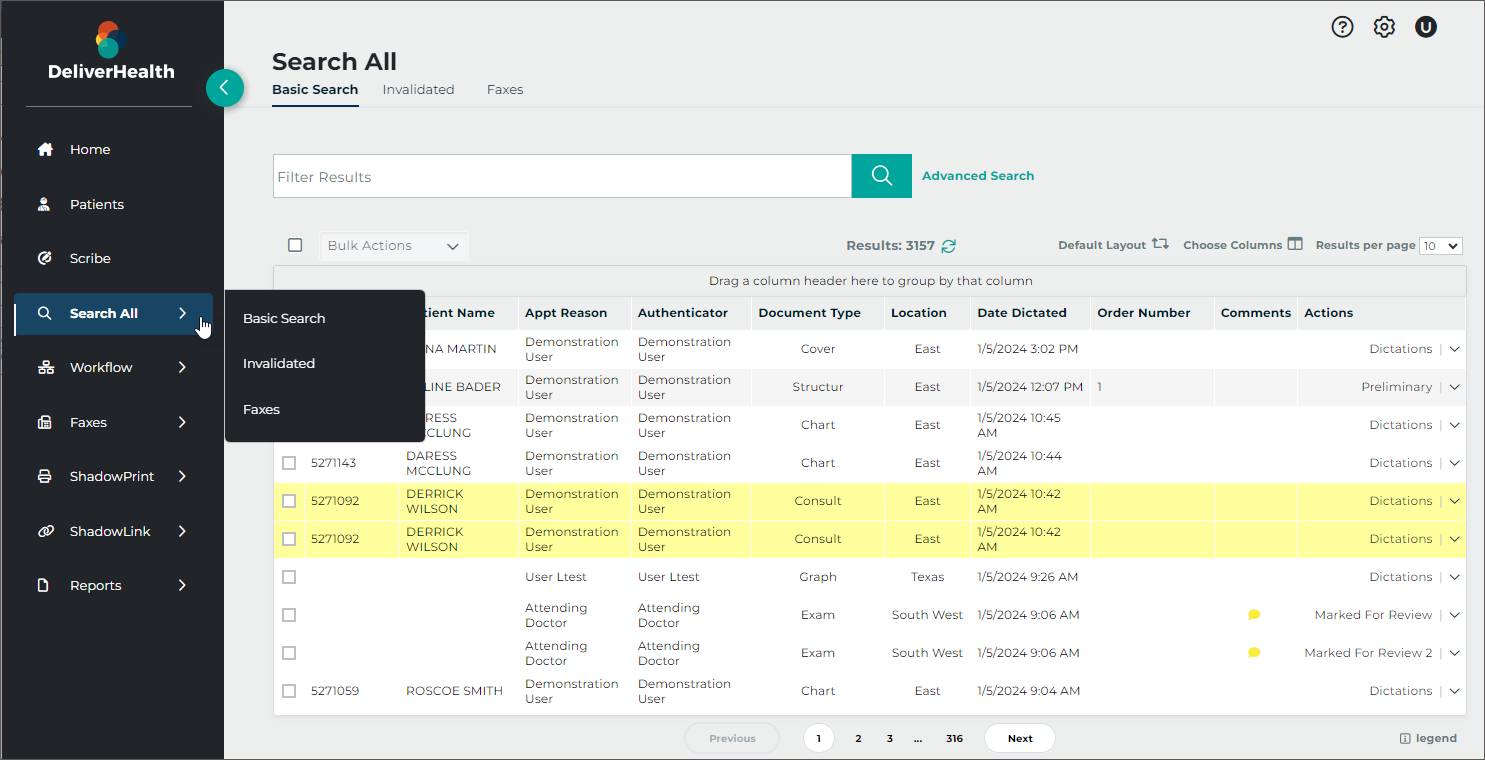
There are three sub-tabs in the Search All folder. Hover the mouse over the Search All tab to expand the list of sub-tabs.
- Basic Search: Search for transcriptions in any stage of the workflow or Search All repository.
- Invalidated: Search for transcriptions that have been removed from the workflow or "deleted." By default, users do not have access to this sub-tab.
- Faxes: Opens the Manage Faxes tab. Search for and view the status of fax jobs, clear fax errors, and re-fax jobs. Manage Faxes can also be opened from the Faxes tab of the navigation menu.
Click the desired sub-tab to navigate to that page. After one of the sub-tabs is loaded the three Search All sub-tabs will appear at the top of the page to allow for easy navigation between searches.
Basic Search¶
Transcriptions currently in or completed through the workflow can be searched for in Basic Search. This is helpful when searching for a transcription without knowing the current workflow status.
 Upon opening Basic Search, the Advanced Search parameters window is presented. Data is not returned until a search is submitted. If the Advanced Search window is closed without submitting a search, the data grid will be empty. Click on Advanced Search to enter criteria and submit a search.
Upon opening Basic Search, the Advanced Search parameters window is presented. Data is not returned until a search is submitted. If the Advanced Search window is closed without submitting a search, the data grid will be empty. Click on Advanced Search to enter criteria and submit a search.
An Advanced Search must be submitted to further filter the search results. A search can be submitted without defining search criteria, but this will return all transcriptions the user has access to, which could result in a lengthy load time or a time-out. The Advanced Search is used to define criteria to ensure relevant transcriptions are returned in the data grid.
Building a Search¶
All fields in the Advanced Search window are optional and all fields, except for "Contains", will search specific data fields. Criteria entered in "Contains" will filter transcriptions returned by the other search criteria and will only match data in the fields displayed in the data grid. Fields can be added to and removed from the data grid before or after search results have been returned. See Data Grid for more details.
- Contains - Filter by full or partial data to match in all or a specified field of the search results data grid; criteria entered here will also appear in the Search text box above the data grid and vice versa. See Filter Search Results below for additional details.
- Patient ID - Search by the patient's full or partial MRN.
- Patient Name - Search by the patient's first, last or full name. Partial and full matches will be returned.
- Location - Select a location to filter on based on the visit location. Select All to search across all locations.
- Clinician - Filter results based on the dictating clinician. To search for a clinician enter a sequence of characters in the search box. The more characters you enter, the more refined your search becomes. You can use alphanumeric and special characters, including spaces, apostrophes, and parentheses. Both first and last names are searched.
- Document Type - Filter results based on the document type. Select "All" to include all document types or choose one document type to find jobs with only that document type.
- Transcription ID - Search for a specific transcription with the full Transcription ID.
- Receipt - Search for a transcription with the full Receipt Code.
- Date Dictated - Enter a start date range to filter the search results based on the Date Dictated. Both date fields are optional and a start or end date can be submitted without the other.
Click clear to remove all advanced search criteria, or search to run the query.
Search criteria submitted in Advanced Search will be displayed under the Filter Results box as a reference.
As an example, searching for the location "East" returned 575 records.

Filter Search Results¶
Once a search has been submitted and data is returned in the grid, a filter can be applied to further refine the results. Criteria entered in the Filter Results text box will be compared to results in the data grid. Any partial or full matches will remain in the data grid and non-matches will be filtered out. If the filter matches a data field on the transcription but is not displayed in the grid, the transcription will be filtered out and removed from the data grid.
To filter across all data fields in the grid, enter the criteria in the filter box. Continuing the example from Building a Search, filtering for "123" returns 66 records with "123" in multiple data fields. The Order Number column has been added to the grid for this example.

To restrict the filter to a particular data field, call out the field name in quotes, followed by a colon, then the data in quotes. The field name must match the header in the data grid. For example, to find records with "123" in the Order Number only, enter "Order Number":"123". Now the results have been filtered down to 40 records.

Multiple filters can be applied by separating the data with a space. All filter criteria must be met. For example, filtering the original search results for "123" in the Order Number, a Document Type of "Chart", and "Mel" in any of the fields in the grid returns 3 results. Note: The Document Type search in Advanced Search could have been used instead of the Document Type filter.
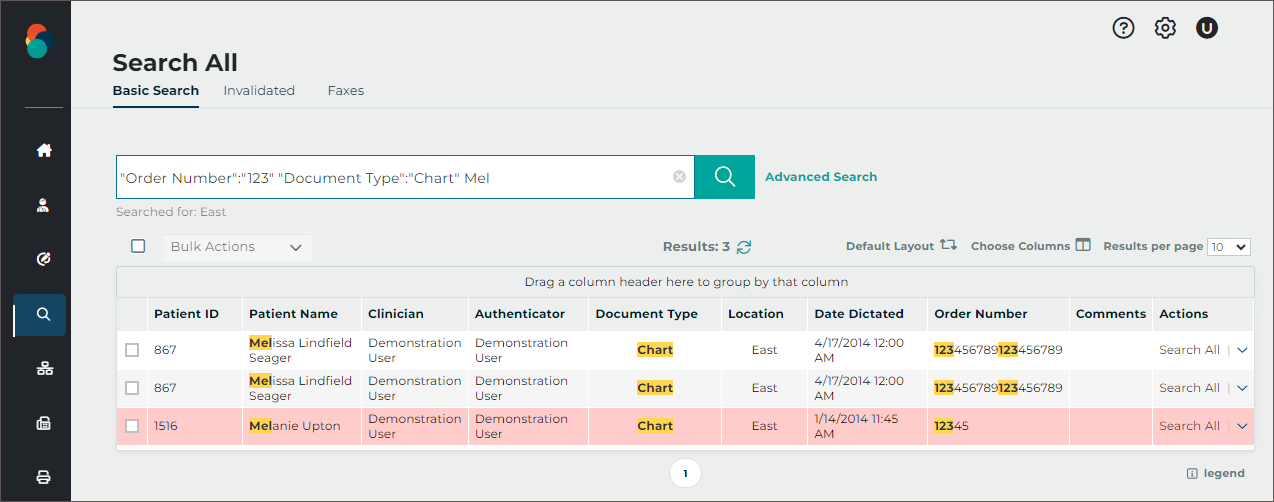
When an additional field is added to the grid, the filters take that field into consideration. For example, the Comment field is added to the grid. "Mel" was found in the comments for a new transcription, which has now been added to the data grid.
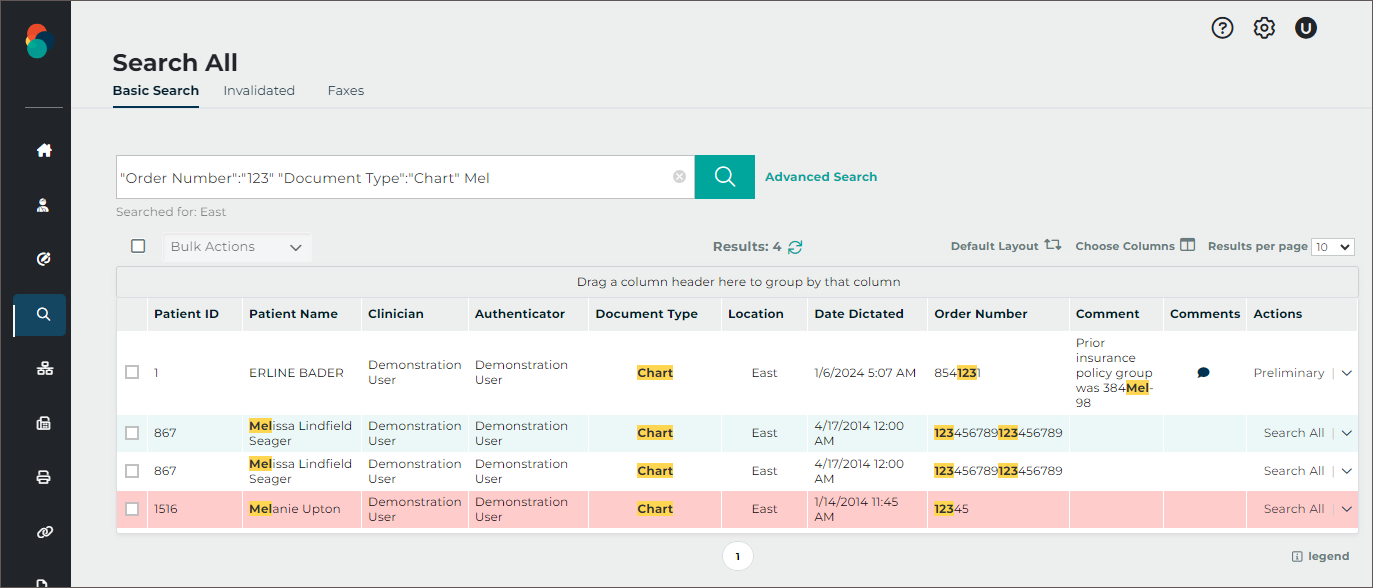
Data Grid¶
The data grid displays transcriptions that match the search criteria and can be customized by changing the included fields, grouping, sorting, and how many results are displayed on each page. Actions can be taken for individual transcriptions or in bulk by selecting multiple or all transcriptions.
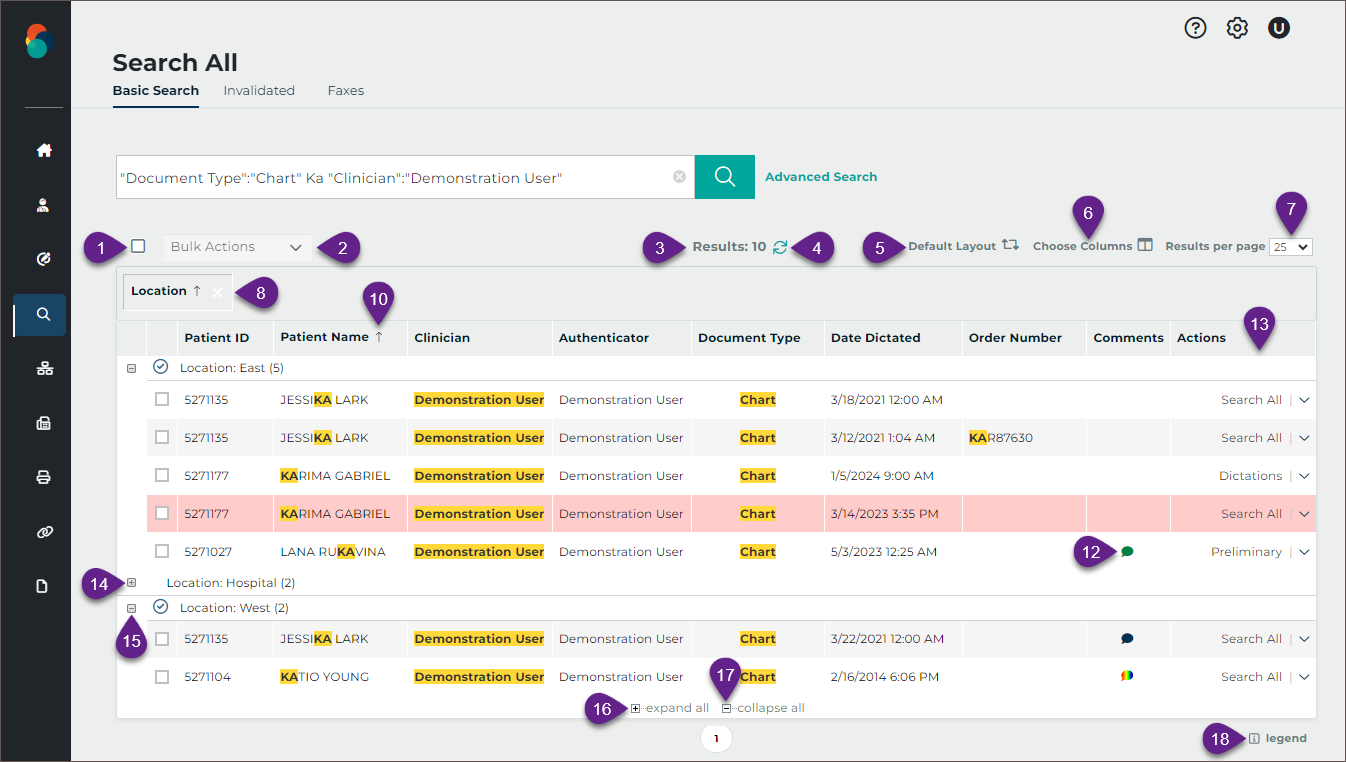
- Filter Results - Allows filters to be applied to data in the grid. Columns with the matching data must be in the grid to match the filter. See Filter Search Results for more details.
- Advanced Search - Opens the Advanced Search window to specify search criteria. See Building a Search for more details.
- Select All - Toggles between selecting and unselecting all transcriptions on the current page of the search results. Transcriptions on prior and subsequent pages are not selected. Transcriptions with "Dictations" status will not be selected with this option because bulk actions cannot be applied to dictations not yet typed.
- Bulk Actions - Choose an action to apply to selected transcriptions. See Actions for more information.
- Results - Displays a count of matching appointment records.
- Refresh - The refresh button performs the same search again.
- Default Layout - Resets the data grid to the default layout, removing any changes previously made to the included columns, grouping, and sorting.
- Choose Columns - Opens the Column Chooser. Drag columns from the chooser to the desired location in the grid to add a new column. Drag a column from the grid to the Column Chooser to remove a column.
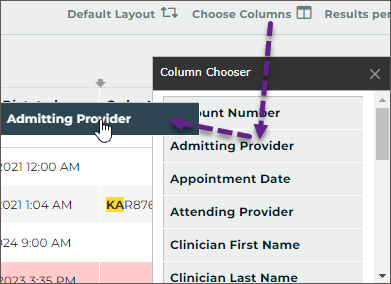
- Results per page - Choose how many appointment records to return per grid page.
- Group - Drag any column header from the grid or Choose Columns window to the grouping row to group the results based on that data criteria. For example, drag Location to the grouping row to group all appointments at the same location together. Multiple groups can be added. Groups will automatically be used to sort the data. Click the group column to toggle between ascending and descending order.
- Reorder - Drag and drop columns to reorder grid columns.

- Sort - Click any column header to sort results by data in that column. Click the column header again to toggle between ascending and descending order. The sort order will be identified by an up arrow (ascending) or down arrow (descending). To sort by multiple columns hold the Shift key while clicking the column headers; data is sorted by the first column added to the sort, then by the second column added, and so on. To remove the sort from a column hold the Ctrl key while clicking the column header.
- Remove Column - Hover the mouse pointer over the column header and click X, or drag the column into the Choose Columns window to remove it from the grid.

- Comments - Open the transcription comment window to view, edit, or remove comments and comment tags. See Comments for more information.
- Actions - The Actions column displays the status of the transcription and allows actions to be taken. If the transcription is in the workflow, the name of the folder will be displayed; if the transcription has completed the workflow, "Search All" will be displayed. Click
 to view additional actions that can be taken. See Actions for more information.
to view additional actions that can be taken. See Actions for more information. - Expand Group - Click + at the head of a collapsed group to display all records within the group.
- Collapse Group - Click - at the head of an expanded group to hide all records within the group.
- Expand all - Click to display all records for all groups.
- Collapse all - Click to hide records for all groups.
- Legend - Opens the legend for color-coded transcriptions. See Legend for more information.
Comment vs Comments
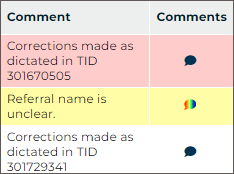
The Comments column is in the default grid layout and displays an icon when a transcription has a comment and/or comment tag. The icon can be clicked to open the comment/tags window.
The Comment column can be added to the grid and will display the comment text, but not comment tags.
Legend¶
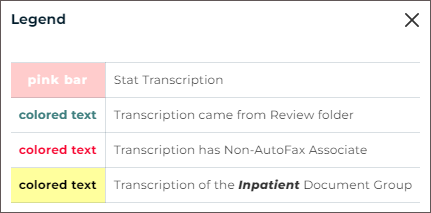 The background and/or text color of each transcription line item in the search results may indicate a specific group or priority status of the transcription. To open the legend for these color codes, click on legend in the bottom right corner under the search results. Some color indicators, such as Non-AutoFax Associate and transcriptions coming from the Review folder, will not apply in the Search All folder, but will apply in the workflow folders. Colors and document groups can be customized per client and may not match what is shown here.
The background and/or text color of each transcription line item in the search results may indicate a specific group or priority status of the transcription. To open the legend for these color codes, click on legend in the bottom right corner under the search results. Some color indicators, such as Non-AutoFax Associate and transcriptions coming from the Review folder, will not apply in the Search All folder, but will apply in the workflow folders. Colors and document groups can be customized per client and may not match what is shown here.
Comments¶
If a transcription has a comment and/or comment tag(s) an icon will appear in the Comments column. Click icon to open the transcription comment window where the comments and comment tags can be viewed, edited or deleted. There are three different types of comment icons to indicate the type/number of comments on the transcription:
 A black-filled comment icon indicates a typed comment has been added to the transcription.
A black-filled comment icon indicates a typed comment has been added to the transcription. A color-filled comment icon indicates a comment tag (a predefined comment) has been added to the transcription and a text comment may also be included. A different color can be assigned to each comment tag; if only one comment tag appears on the transcription then the color assigned to that comment tag will fill the comment icon.
A color-filled comment icon indicates a comment tag (a predefined comment) has been added to the transcription and a text comment may also be included. A different color can be assigned to each comment tag; if only one comment tag appears on the transcription then the color assigned to that comment tag will fill the comment icon. A rainbow-filled comment icon indicates multiple comment tags have been added to the transcription and a text comment may also be included.
A rainbow-filled comment icon indicates multiple comment tags have been added to the transcription and a text comment may also be included.
Basic Search Actions¶
By default, clicking a transcription from the Basic Search data grid will open the Transcription Viewer. Depending on user settings, additional actions can be selected from the Transcription Viewer button ribbon.
 The Actions column in the Basic Search data grid displays the status of the transcription and allows actions to be taken. If the transcription is in the workflow, the name of the folder will be displayed; if the transcription is in multiple folders, such as Marked for Review and Review 2, it will appear in the grid twice (once for each folder). If the transcription has completed the workflow, "Search All" will be displayed.
The Actions column in the Basic Search data grid displays the status of the transcription and allows actions to be taken. If the transcription is in the workflow, the name of the folder will be displayed; if the transcription is in multiple folders, such as Marked for Review and Review 2, it will appear in the grid twice (once for each folder). If the transcription has completed the workflow, "Search All" will be displayed.
The Actions column also provides a selection of actions to perform for the given transcription. Available actions vary based on user access and the status of the transcription. From Search All, actions may include playing the dictation, edit, print, fax, and complete the transcription from the current workflow folder. Click  to view available actions for the given transcription.
to view available actions for the given transcription.
The Play option opens the playback control to allow users to play/pause audio. Users can also play/pause the audio using the Ctrl+Space shortcut. Foot pedals that are capable of being configured to send specific keystrokes can be used to play/pause audio as well. Please refer to your foot pedal manufacturer's user manual for assistance in configuring the Ctrl+Space shortcut. Dictations are stored on the eSOne system for 90-days and cannot be played after that time. The Play option will not appear when the dictation is not available.
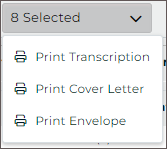
Printing transcriptions, cover letters and envelopes for multiple transcriptions at once can be achieved by selecting the desired transcriptions with the check box at the beginning of each row, or the select-all box above the grid, then clicking the appropriate print option in the bulk action menu. Specific dictators or document types may not generate envelopes or cover letters.
Note
A separate printing component is required to print transcriptions. The user will be prompted to download it if it is not found when printing is initiated. See the Printing Agent User Guide.
Invalidated¶
The Invalidated tab gives access to transcriptions that have been invalidated or removed. There are several reasons a transcription could be invalidated. If a dictation remains untyped for an extended period of time it may be automatically invalidated. Some clinicians may mistakenly dictate on the same appointment twice, asking that one be invalidated. Regardless of the reason, invalidated transcriptions can be searched for and restored from the Invalidated tab.
The search and data grid performs the same as Search All - Basic Search. See Basic Search for details on how to build a search. Search results will be displayed in the data grid.
Invalidated Actions¶
The Actions column of the data grid will display one of two statuses:
- Transcription - Prior to being invalidated, the transcription was completed by the transcription company.
- Not Transcribed - The dictation was invalidated prior to the transcription being delivered by the transcription company.
Faxes¶
Facsimiles are generated through Fax on Demand or by utilizing the eSOne AutoFax or Distribution Rules features. There are search tabs in Faxes, Manage Faxes and Pending Faxes to help manage fax jobs. See Faxes for additional details.